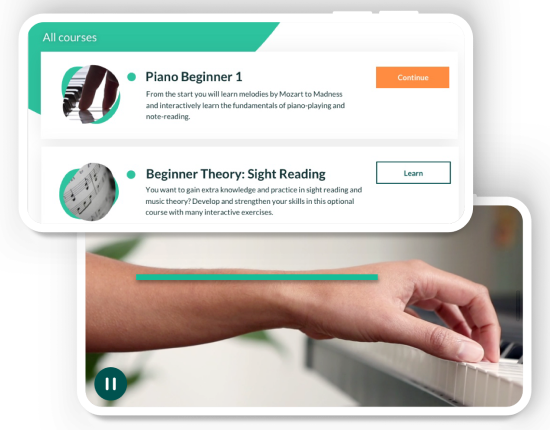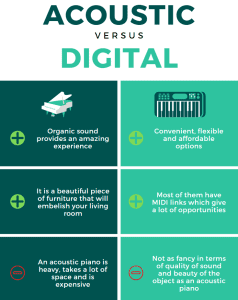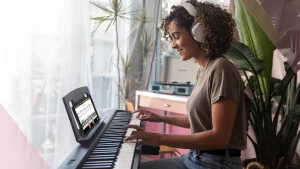Table of Contents
If you’re about to buy a piano, it’s a pretty big deal and there are several things to consider before you take the plunge.. How much do you want to spend? Where are you going to put it? And the biggest question – acoustic or digital?

What’s the difference?
Acoustic pianos are “real” pianos. The case is solid wood and cradles the soundboard, 220 strings, hammers, and many other moving parts.
Although we call the instrument a “piano”, its real name is “pianoforte”. In Italy, where the piano was invented, “piano” means “soft” and “forte” means loud. This is what gives the piano its distinctive character – having the ability to play very loud, very soft and everything in between.
Digital pianos are electronic and don’t have nearly as many moving parts. They produce sampled piano sounds through built-in speakers. As you will see, there are certain benefits to this.
Main considerations
Here are the most important things that need serious thought before you take the plunge:
- Space and environment
- Noise element
- Level and commitment of the piano player
- Budget available
Measure your space
Acoustic pianos take up more space than digitals. Grand pianos start at 5 foot (1.5 meters) in length and go up to 9 foot (2.7 meters), but it’s rare anyone would have a piano bigger than 7 foot (2.1 meters) in their house! (9 foot is considered a concert grand, and will be found in concert halls).

Upright pianos are usually placed against a wall and take up a lot less space than a grand (although the width will be approximately the same on both).
Digital pianos can look sleek and elegant, take up a lot less space and can be moved very easily. However, they don’t have the visual impact on a room that an acoustic has.
Gauge the noise level
An acoustic piano in any setting is going to be louder than a digital. The natural reverberation of the strings will see to that! However, if you put an acoustic in a carpeted room with drapes, sofas, and cushions, the soft furnishings will help mute the sound.
With digital pianos, you always have the option of lowering the volume on the instrument, or using headphones. The sound comes through speakers on a digital piano so it doesn’t bounce around the room as much.
Consider the piano player
An advanced pianist is certainly going to appreciate an acoustic over digital. However, digital pianos are absolutely fine for a beginner, high-to-middle intermediate player, or even a pianist who plays a lot of pop, singer-songwriter, or jazz.
Decide on a budget
A brand new acoustic piano can range from around $2000 to $50,000. There is a good market for second-hand pianos and sometimes you can find a gem for a really good price or even for free! Don’t forget to factor in moving costs, which can be pricey.
A family where the children have flown the nest might be downsizing and decide it’s time to say goodbye to their piano. Or someone might be upgrading and selling a pretty good instrument for a beginner.
Look in your local paper and online. Gumtree is a good source, as is Ebay. Never buy a second hand piano sight unseen – try it in person. It’s best to have a piano technician check it over to make sure there are no issues with the moving parts and no cracks in the soundboard. Be aware that buying second hand means you’re unlikely to have a warranty, unless you buy from a reputable dealer.
Acoustic Pluses and Minuses
Great things about acoustic pianos
The main great thing about the acoustic piano is, not surprisingly, the organic sound. Although the major manufacturers in the digital piano industry are getting ever closer to the sound of an acoustic, it’s still not quite there yet.
Playing classical music on an acoustic piano can be an amazing experience! With Skoove you can play Clair de Lune by Claude Debussy and other famous classical pieces.
The piano is a beautiful, long-lasting piece of furniture that enhances any home and often becomes a family heirloom. Properly looked after, it can be passed through the generations with happy memories and emotional ties.
If your dream is to play classical music by the great masters of piano music, Skoove can help with the Classic Course. The AI powered pitch recognition uses the microphone so you don’t need any cables. Just open Skoove, choose your lesson, pop your device on the music stand and away you go. If you’re a beginner, try Au Clair De La Lune
The downside of acoustic pianos
The main downside of having an acoustic piano is the sheer size and weight. Once in place in your home, it stays put. Unless you have a couple of very strong people who know what they’re doing – or you higher a specialist piano mover to reposition it. A baby grand averages around 500lbs.
Acoustic pianos need to be cared for in a very specific way. They are fussy, sensitive and very particular about their surroundings – particularly temperature and humidity. They don’t really like to be moved about too much either. If they are, they will quickly go out of tune, and notes might get stuck or not play.
Pianos need tuning regularly. How often depends on the piano and amount of use it gets – but as a general rule, they should be tuned every six months.
The case of a piano just needs dusting once a week with a soft cloth. Depending on the finish, it might require some special polish.

Digital Pluses and Minuses
Great things about digital pianos
Every year, digital piano manufacturers step up their game and make them even better, adding more reasons to consider them over an acoustic.
The main thing pianists don’t like about playing a digital is that the notes don’t “feel” the same as an acoustic. This is becoming less and less true as they find ways to mimic the real thing.
Some digital pianos now come with weighted wooden keys that respond in a very similar way to an acoustic. Some even have actual hammers with a similar striking action, even though there are no strings for the hammer to hit.
Likewise, sampling of real piano sounds has become such a fine art that there are times it’s difficult to tell the difference between an acoustic and a digital.
Additionally, digital pianos have several really important pluses that make them a serious contender even for professional pianists:
Unlike a hefty acoustic, most digital pianos can be easily moved into a different room in a couple of minutes, carried by one or two people.
Digital pianos are not nearly as sensitive to their surroundings as acoustic pianos. Heat and humidity won’t affect them. Of course they are electronic, so you still have to be careful to plug them in correctly and not have drinks near them. However, they are more robust and can take a bit of a beating, compared to an acoustic.
Digital pianos don’t go out of tune and so don’t need tuning, ever. This is a time and money saver.
Perhaps the biggest plus of a digital is that you’re unlikely to disturb your neighbors or people around you when you play. Simply turn down the volume or use headphones.

Digital pianos have MIDI capability and that makes them able to do all kinds of cool things. You can link a digital to your iphone or iPad and use interactive scores, transfer files and much more. Although it’s great to learn from an App such as Skoove when you have an acoustic, having the MIDI or even wireless Bluetooth connection – makes it that much easier.
Virtually all digital pianos have recording capability and this can be a wonderful thing. Record a practice session or something you’ve composed. Save the file and share it, or use it to compare another practice session to gauge your progress. (You can of course record yourself playing an acoustic, but it’s not so streamlined). Digitals all have a built-in metronome as standard.
Many digitals have multiple choices of sounds. Some have different piano sounds. Why would you need that? Well, certain types of music sound better on certain pianos. For instance, classical piano such as Chopin or Debussy sounds beautiful on a soft, felty sounding piano. Jazz or pop usually sounds best on a brighter, edgier sounding piano.
Having the option to change your piano at the push of a button can be an inspiring and useful thing.
Many digitals also come with other sounds, such as percussion – drum kits with pre-programmed drum tracks that you can play along to. Or an acoustic bass sound which you can assign to the lower end of the piano and play with your left hand while you play a piano sound in the right hand and voilà! – you have your very own combo.
If you’re an aspiring Music Producer, you might find a digital gives you far more sounds and recording options than an acoustic. It’s critical to have keyboard and music theory skills in order to produce music. You’ll find everything you need to learn in Skoove’s Music Producer Course. Check out “Lose Yourself” and learn how to create chord progressions!
Digitals are a lot more affordable than acoustics with the top end at around the $2000 point, but very good instruments can be a lot less and are a good choice for beginners.
The downside of digital pianos
Any classical pianist will say the main downside of a digital piano is that it isn’t an acoustic piano. When you play an acoustic, using the pedal, every string resonates with every other string, creating a living, vibrating sound that a digital can’t quite match. New models come very close, but it’s just not the same.
Digitals don’t have the same “wow” factor as a piece of furniture. It’s fairly impossible to go into a room with an acoustic and not notice it, whereas it’s quite easy not to notice a digital.
Some digital pianos are designed to look like an upright or a very small grand, and these are more imposing, but still can’t quite compete with a real piano when it comes to making a statement.
Beware of buying second hand digital pianos. If the warranty has run out, be careful. It can be difficult to get digital pianos repaired and it can mean packing the piano up and posting it to a dealer so it can get expensive and inconvenient.

Why not have both?
You can’t really beat having an acoustic piano. It has a soul and a personality in a way that a digital doesn’t. But it’s just not always practical. If you have the budget, consider owning an acoustic as well as a digital.
It might sound rather extravagant, and of course, it depends on how serious you are about playing the piano and what your budget is. But it can pay off big time when it comes to practice. For instance, if you have an acoustic and you feel you can’t play because you’ll disturb neighbors or people around you, you might find that you hardly ever play.
On the other hand, if you just have a digital piano, you might find you don’t enjoy playing it as much and shy away from practicing.
Having one of each ensures that, whatever the situation, you can play.
You might know already that the discipline of practicing can be slippery for most people, so the more excuses you can delete, the better!
If you don’t want to take up extra room with two different instruments, consider this: Yamaha and Kawai have beautifully made acoustic pianos which include in-built digital pianos that you can switch to with the press of a button. When you switch to electronic, the hammers are held back from hitting the strings, it turns on the digital piano and the sound floats through the built-in speakers. This gives you the satisfaction of the feel of a real piano – because it IS a real piano – but the flexibility of volume control and the option of using headphones.
These hybrids are expensive, to be sure, but you’re purchasing two instruments, not just one. They just happen to share a case.
And yet another option – a new type of piano might be on the way soon. A pianist who has been aggravated by the weight of a cumbersome grand piano is currently redesigning the grand to sit in the same space as an upright. This isn’t going to make neighbors happy sound-wise, but might eventually make moving an acoustic piano much easier.
Finally
If you’re a beginner and you’re not really sure how you’re going to get on, it’s sensible to start with a digital and see how it goes.
To give yourself a head start, Skoove offers a great course for beginners who want to gain extra knowledge and practice in sight reading and music theory.
Have some fun with Lean on Me which explains finger numbers.
Remember that most instruments have a resale value as long as you look after them.
Buy the best you can afford and enjoy your journey on the piano!
Do you still have doubts about which piano should you buy? Check this video!
Try out your free trial of Skoove today!
Author of this blog post:
Georgina St George has been playing piano most of her life. She has a thriving piano school on the south coast of England. She loves to infuse her students with her passion for music, composing and performing. Her music has been featured on over 100 TV shows and her musicals have been performed in New York and London’s West End.











